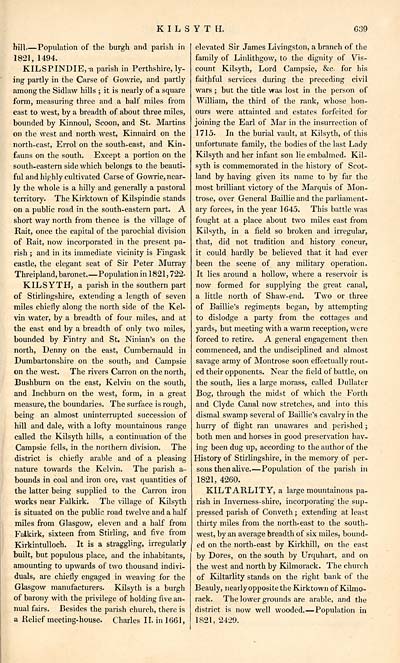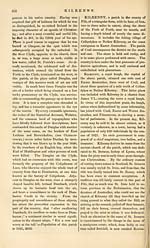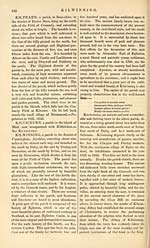Gazetteer of Scotland > Volume 2
(155) Page 639
Download files
Complete book:
Individual page:
Thumbnail gallery: Grid view | List view

KILSYTH.
639
hill — Population of the burgh and parish in
1821, 1494.
KILSPINDIE,-a parish in Perthshire, ly-
ing partly in the Carse of Gowrie, and partly
among the Sidlaw hills ; it is nearly of a square
form, measuring three and a half miles from
east to west, by a breadth of about three miles,
bounded by Kinnoul, Scoon, and St. Martins
on the west and north west, Kinnaird on the
north-east, Errol on the south-east, and Kin-
fauns on the south. Except a portion on the
south-eastern side which belongs to the beauti-
ful and highly cultivated Carse of Gowrie, near-
ly the whole is a hilly and generally a pastoral
territory. The Kirktown of Kilspindie stands
on a public road in the south-eastern part. A
short way north from thence is the village of
Rait, once the capital of the parochial division
of Rait, now incorporated in the present pa-
rish ; and in its immediate vicinity is Fingask
castle, the elegant seat of Sir Peter Murray
Threipland, baronet. — Population in 1821, 722-
KILSYTH, a parish in the southern part
of Stirlingshire, extending a length of seven
miles chiefly along the north side of the Kel-
vin water, by a breadth of four miles, and at
the east end by a breadth of only two miles,
bounded by Fintry and St. Ninian's on the
north, Denny on the east, Cumbernauld in
Dumbartonshire on the south, and Campsie
on the west. The rivers Carron on the north,
Bushburn on the east, Kelvin on the south,
and Inchburn on the west, form, in a great
measure, the boundaries. The surface is rough,
being an almost uninterrupted succession of
hill and dale, with a lofty mountainous range
called the Kilsyth hills, a continuation of the
Campsie fells, in the northern division. The
district is chiefly arable and of a pleasing
nature towards the Kelvin. The parish a-
bounds in coal and iron ore, vast quantities of
the latter being supplied to the Carron iron
works near Falkirk. The village of Kilsyth
is situated on the public road twelve and a half
miles from Glasgow, eleven and a half from
Falkirk, sixteen from Stirling, and five from
Kirkintulloch. It is a straggling, irregularly
built, but populous place, and the inhabitants,
amounting to upwards of two thousand indivi-
duals, are chiefly engaged in weaving for the
Glasgow manufacturers. Kilsyth is a burgh
of barony with the privilege of holding five an-
nual fairs. Besides the parish church, there is
a Relief meeting-house. Charles II. in 1661,
elevated Sir James Livingston, a branch of the
family of Linlithgow, to the dignity of Vis-
count Kilsyth, Lord Campsie, &c- for his
faithful services during the preceding civil
wars ; but the title was lost in the person of
William, the third of the rank, whose hon-
ours were attainted and estates forfeited for
joining the Earl of Mar in the insurrection of
1715. In the burial vault, at Kilsyth, of this
unfortunate family, the bodies of the last Lady
Kilsyth and her infant son lie embalmed. Kil-
syth is commemorated in the history of Scot-
land by having given its name to by far the
most brilliant victory of the Marquis of Mon-
trose, over General Baillie and the parliament-
ary forces, in the year 1 645. This battle was
fought at a place about two miles east from
Kilsyth, in a field so broken and irregular,
that, did not tradition and history concur,
it could hardly be believed that it had ever
been the scene of any military operation.
It lies around a hollow, where a reservoir is
now formed for supplying the great canal,
a little north of Shaw-end. Two or three
of Baillie's regiments began, by attempting
to dislodge a party from the cottages and
yards, but meeting with a warm reception, were
forced to retire. A general engagement then
commenced, and the undisciplined and almost
savage army of Montrose soon effectually rout-
ed their opponents. Near the field of battle, on
the south, lies a large morass, called Dullater.
Bog, through the midst of which the Forth
and Clyde Canal now stretches, and into this
dismal swamp several of Baillie's cavalry in the
hurry of flight ran unawares and perished ;
both men and horses in good preservation hav-
ing been dug up, according to the author of the
History of Stirlingshire, in the memory of per-
sons then alive. — Population of the parish in
1821, 4260.
KILTARLITY, a large mountainous pa-
rish in Inverness-shire, incorporating the sup-
pressed parish of Conveth ; extending at least
thirty miles from the north-east to the south-
west, by an average breadth of six miles, bound-
ed on the north-east by Kirkhill, on the east
by Dores, on the south by Urquhart, and on
the west and north by Kilmorack. The church
of Kiltarlity stands on the right bank of the
Beauly, nearly opposite the Kirktown of Kilmo-
rack. The lower grounds are arable, and the
district is now well wooded. — Population in
1821, 2429.
639
hill — Population of the burgh and parish in
1821, 1494.
KILSPINDIE,-a parish in Perthshire, ly-
ing partly in the Carse of Gowrie, and partly
among the Sidlaw hills ; it is nearly of a square
form, measuring three and a half miles from
east to west, by a breadth of about three miles,
bounded by Kinnoul, Scoon, and St. Martins
on the west and north west, Kinnaird on the
north-east, Errol on the south-east, and Kin-
fauns on the south. Except a portion on the
south-eastern side which belongs to the beauti-
ful and highly cultivated Carse of Gowrie, near-
ly the whole is a hilly and generally a pastoral
territory. The Kirktown of Kilspindie stands
on a public road in the south-eastern part. A
short way north from thence is the village of
Rait, once the capital of the parochial division
of Rait, now incorporated in the present pa-
rish ; and in its immediate vicinity is Fingask
castle, the elegant seat of Sir Peter Murray
Threipland, baronet. — Population in 1821, 722-
KILSYTH, a parish in the southern part
of Stirlingshire, extending a length of seven
miles chiefly along the north side of the Kel-
vin water, by a breadth of four miles, and at
the east end by a breadth of only two miles,
bounded by Fintry and St. Ninian's on the
north, Denny on the east, Cumbernauld in
Dumbartonshire on the south, and Campsie
on the west. The rivers Carron on the north,
Bushburn on the east, Kelvin on the south,
and Inchburn on the west, form, in a great
measure, the boundaries. The surface is rough,
being an almost uninterrupted succession of
hill and dale, with a lofty mountainous range
called the Kilsyth hills, a continuation of the
Campsie fells, in the northern division. The
district is chiefly arable and of a pleasing
nature towards the Kelvin. The parish a-
bounds in coal and iron ore, vast quantities of
the latter being supplied to the Carron iron
works near Falkirk. The village of Kilsyth
is situated on the public road twelve and a half
miles from Glasgow, eleven and a half from
Falkirk, sixteen from Stirling, and five from
Kirkintulloch. It is a straggling, irregularly
built, but populous place, and the inhabitants,
amounting to upwards of two thousand indivi-
duals, are chiefly engaged in weaving for the
Glasgow manufacturers. Kilsyth is a burgh
of barony with the privilege of holding five an-
nual fairs. Besides the parish church, there is
a Relief meeting-house. Charles II. in 1661,
elevated Sir James Livingston, a branch of the
family of Linlithgow, to the dignity of Vis-
count Kilsyth, Lord Campsie, &c- for his
faithful services during the preceding civil
wars ; but the title was lost in the person of
William, the third of the rank, whose hon-
ours were attainted and estates forfeited for
joining the Earl of Mar in the insurrection of
1715. In the burial vault, at Kilsyth, of this
unfortunate family, the bodies of the last Lady
Kilsyth and her infant son lie embalmed. Kil-
syth is commemorated in the history of Scot-
land by having given its name to by far the
most brilliant victory of the Marquis of Mon-
trose, over General Baillie and the parliament-
ary forces, in the year 1 645. This battle was
fought at a place about two miles east from
Kilsyth, in a field so broken and irregular,
that, did not tradition and history concur,
it could hardly be believed that it had ever
been the scene of any military operation.
It lies around a hollow, where a reservoir is
now formed for supplying the great canal,
a little north of Shaw-end. Two or three
of Baillie's regiments began, by attempting
to dislodge a party from the cottages and
yards, but meeting with a warm reception, were
forced to retire. A general engagement then
commenced, and the undisciplined and almost
savage army of Montrose soon effectually rout-
ed their opponents. Near the field of battle, on
the south, lies a large morass, called Dullater.
Bog, through the midst of which the Forth
and Clyde Canal now stretches, and into this
dismal swamp several of Baillie's cavalry in the
hurry of flight ran unawares and perished ;
both men and horses in good preservation hav-
ing been dug up, according to the author of the
History of Stirlingshire, in the memory of per-
sons then alive. — Population of the parish in
1821, 4260.
KILTARLITY, a large mountainous pa-
rish in Inverness-shire, incorporating the sup-
pressed parish of Conveth ; extending at least
thirty miles from the north-east to the south-
west, by an average breadth of six miles, bound-
ed on the north-east by Kirkhill, on the east
by Dores, on the south by Urquhart, and on
the west and north by Kilmorack. The church
of Kiltarlity stands on the right bank of the
Beauly, nearly opposite the Kirktown of Kilmo-
rack. The lower grounds are arable, and the
district is now well wooded. — Population in
1821, 2429.
Set display mode to: Large image | Transcription
Images and transcriptions on this page, including medium image downloads, may be used under the Creative Commons Attribution 4.0 International Licence unless otherwise stated. ![]()
| Gazetteers of Scotland, 1803-1901 > Gazetteer of Scotland > Volume 2 > (155) Page 639 |
|---|
| Permanent URL | https://digital.nls.uk/97432682 |
|---|
| Description | Volume II: Glenbanchor to Zetland. |
|---|---|
| Attribution and copyright: |
|
| Description | By Robert Chambers and William Chambers. Glasgow: Blackie & Son, 1838. 2 volumes. |
|---|---|
| Shelfmark | NF.1461.g.7 |
| Additional NLS resources: | |

